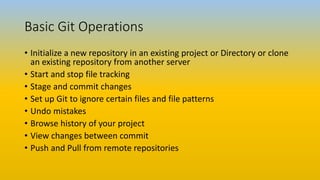Devops and git basics
- 1. DevOps and Git Basics Sourabh Saxena
- 2. DevOps DevOps is a Organizational cultural shift âĒ Operations traditionally seeks STABILITY âĒ Developers traditionally seeks CHANGE âĒ Testers traditionally seeks REDUCE RISKS How to accomplish DevOps ? âĒ Strong interdepartmental communication âĒ Team Building
- 3. Why DevOps ? Inefficiencies existed in both development and operations âĒ Operations used inefficient tools . âĒ Developers didn't control the infrastructure . What was needed ? âĒ Operations needed to leverage more efficient developer tools . âĒ Developers needed to manage their own infrastructure .
- 4. Terminology Term Description Continuous Integration A method of finding software issues early within the development cycle and ensuring that all the parts of the overall platform are integrated to each other correctly . Continuous Delivery A method of delivering fully working and tested software in small incremental chunks to the production platform . DevOps A way of working that encourages Development and Operations teams to work together in a highly collaborative way towards Continuous Delivery. Definition of Done A change to the platform (software, hardware , infrastructure and so on) is live and used by customers . Release (candidate ) A single code drop to a given environment (testing , staging ,production and so on)
- 5. Continuous Integration ,Continuous Delivery and DevOps âĒ Continuous Integration (CI) : Key component of modern develop ment practices âĒ Continuous Delivery (CD) provides tools and best practices to deliver quality software quickly
- 6. DevOps Framework : Extend Continuous Delivery Deployment Continuous Integration Source control Dev Environment Configuration Mgmt Monitoring Issue Tracking Collaboration Pattern Dev Ops Collaboration Teams work together, regardless of location Source Control Store Project code and access in controlled way Ensure that configuration data is with project code Dev Environment Access development ,reduce setup time and inconsistencies Issue Tracking Raise responsiveness and visibility Continuous Integration Instant feedback by merging code regularly Deployment Build projects and update systems regularly with new builds Build target environments with respective configuration data Planning Build transparency to stakeholders always (culture tenet) Configuration Mgmt Enforce desired state and consistency at scale Monitoring Shared responsibility for relevant parts of application/environment health Planning
- 7. DevOps Life Cycle âĒ Continuous Rather than ending when the code is âliveâ , the cycle continues by monitoring the current release and working toward the next . START BUILD TEST RELEASE DEPLOYOPERATEMONITOR PLAN CODE
- 8. Configuration Management Scripts âĒ Install.sh âĒ Setup.sh âĒ Etc. .. Test Changes âĒ Unit test âĒ Integration test âĒ Pre-production âĒ Environment production Documentation âĒ Changes âĒ Release notes âĒ Modify wiki âĒ Version control (git) Images âĒ Golden Images âĒ Snapshots âĒ Provisioning âĒ Access credentials Deployments âĒ Golden Images âĒ Snapshots âĒ Provisioning âĒ Access credentials Continuous Integration and Delivery Pipeline Push Feature Branch to Git Linting ,Unit Testing , Integration testing Pass / Approve Changes Merge to Master , Distribute Changes Update Environments ,Push to Production
- 9. What is Git ? âĒ A Distributed version control system âĒ Characteristics : ïSpeed ïSimple Design ïFully Distributed ïCan handle large projects efficiently ïSupports non-linear development ïRequires local file and resources only
- 10. Section of a Git Project âĒ There are three main sections of Git Project : ïGit Directory ïWorking Directory ïStaging Area
- 11. State of files in Git âĒFiles is Git can be in any of the following states â ïCommitted ïStaged ïModified
- 12. Basic Git Operations âĒ Initialize a new repository in an existing project or Directory or clone an existing repository from another server âĒ Start and stop file tracking âĒ Stage and commit changes âĒ Set up Git to ignore certain files and file patterns âĒ Undo mistakes âĒ Browse history of your project âĒ View changes between commit âĒ Push and Pull from remote repositories
- 13. Git Workflow Create or modify files Add files to commit Commit Pull from Remote Push to Remote Ignore files using .gitignore Check Status Check Status
- 14. Thanks âĶ














